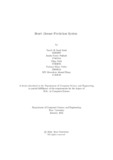| dc.contributor.advisor | Mostakim, Moin | |
| dc.contributor.advisor | Ashraf, Faisal Bin | |
| dc.contributor.author | Amit, Tayab Al Azad | |
| dc.contributor.author | Fullkoli, Raida Nawar | |
| dc.contributor.author | Palit, Niloy | |
| dc.contributor.author | Nafisa, Farhana Khan | |
| dc.contributor.author | Binoy, MD Muntakim Ahmed | |
| dc.date.accessioned | 2022-06-06T04:33:41Z | |
| dc.date.available | 2022-06-06T04:33:41Z | |
| dc.date.copyright | 2022 | |
| dc.date.issued | 2022-01 | |
| dc.identifier.other | ID 18201197 | |
| dc.identifier.other | ID 17301204 | |
| dc.identifier.other | ID 17301094 | |
| dc.identifier.other | ID 19101654 | |
| dc.identifier.other | ID 17201048 | |
| dc.identifier.uri | http://hdl.handle.net/10361/16900 | |
| dc.description | This thesis is submitted in partial fulfillment of the requirements for the degree of Bachelor of Science in Computer Science and Engineering, 2022. | en_US |
| dc.description | Cataloged from PDF version of thesis. | |
| dc.description | Includes bibliographical references (pages 30-32). | |
| dc.description.abstract | [1]According to the World Health Organization (WHO), 17.9 million people die
each year due to cardiovascular diseases (CVDs), almost 31% of all deaths worldwide.
This single piece of evidence is strong enough to describe the lethal nature
of cardiovascular diseases or, as we know, heart diseases. There is no denying that
different medical sectors using the help of high-end technologies, now have gured
out ways to tackle serious CVDs. However, then again, we indeed cannot rule out
the amount of distress these CVDs bring. We need to know how to prepare ourselves
to face di erent heart diseases. One of the many ways can be implementing di erent
Machine Learning and Neural Network algorithms. Say, for example, in this paper;
we will discuss algorithms like Support Vector Machine (SVM), Decision Tree (DT),
Random Forest (RF), Logistic Regression (LR), ConvMLP, and ANN; on how each
of these techniques can be applied to nd out a better way to predict the availability
of heart disease in a particular individual depending on few given factors. Our
main goal is to make the course easy to detect diseases that belong to the heart and
enriches the medical sector. In our country, the medical sector is improving day by
day. We aim to boost this improved significantly. By using Machine Learning and
Neural Network algorithm, we are optimistic about implementing this idea. | en_US |
| dc.description.statementofresponsibility | Tayab Al Azad Amit | |
| dc.description.statementofresponsibility | Raida Nawar Fullkoli | |
| dc.description.statementofresponsibility | Niloy Palit | |
| dc.description.statementofresponsibility | Farhana Khan Nafisa | |
| dc.description.statementofresponsibility | MD Muntakim Ahmed Binoy | |
| dc.format.extent | 32 pages | |
| dc.language.iso | en | en_US |
| dc.publisher | Brac University | en_US |
| dc.rights | Brac University theses are protected by copyright. They may be viewed from this source for any purpose, but reproduction or distribution in any format is prohibited without written permission. | |
| dc.subject | Random Forest Classi fier | en_US |
| dc.subject | Decision tree | en_US |
| dc.subject | Logistic regression | en_US |
| dc.subject | Support vector machine | en_US |
| dc.subject | MLP classifier | en_US |
| dc.subject | Conv-MLP | en_US |
| dc.subject | Neural networks | en_US |
| dc.subject | Heart disease detection | en_US |
| dc.subject.lcsh | Machine learning | |
| dc.subject.lcsh | Neural networks (Computer science) | |
| dc.subject.lcsh | Artificial intelligence. | |
| dc.title | Heart disease prediction system | en_US |
| dc.type | Thesis | en_US |
| dc.contributor.department | Department of Computer Science and Engineering, Brac University | |
| dc.description.degree | B. Computer Science | |

